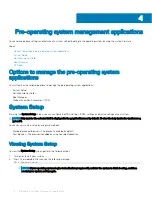
4
On the
System BIOS
screen, click
Boot Settings
.
Boot Settings details
The
Boot Settings
screen details are explained as follows:
Option
Description
Boot Mode
Allows you to configure the Boot Sequence and Enable or Disable the individual boot options. The available options
are
BIOS
and
UEFI
. The option is set to
UEFI
by default.
Boot Sequence
Retry
Enables or disables the
Boot Sequence Retry
feature. If this option is set to
Enabled
and the system fails to boot,
the system re-attempts the boot sequence after 30 seconds. This option is set to
Enabled
by default.
Hard-Disk Failover
Specifies the drive that is booted in the event of a drive failure. The devices are selected in the
Hard-Disk Drive
Sequence
on the
Boot Option Setting
menu. When this option is set to
Disabled
, only the first drive in the list is
attempted to boot. When this option is set to
Enabled
, all drives are attempted to boot in the order selected in the
Hard-Disk Drive Sequence
. This option is not enabled for
UEFI Boot Mode
. This option is set to
Disabled
by
default.
Generic USB Boot
When set to
Enabled
, a Generic USB Boot placeholder will be placed in the UEFI Boot Sequence, which will map to
the first bootable USB device in the boot sequence. This allows the entry to remain present even if the USB device
is not present. This is only available in
UEFI Mode
.
Hard-disk Drive
Placeholder
When set to
Enabled
, a Generic RAID HDD placeholder will be placed in the UEFI boot sequence. The entry will
remain present until an operating system or a bootable file is installed on the RAID disk. This setting is only available
in
UEFI Boot Mode
.
UEFI Boot Settings
The
UEFI Boot Settings
enables you to specify the UEFI boot order.
Option
Description
UEFI Boot
Sequence
Enables you to change the
UEFI
boot device order.
Boot Options
Enable/Disable
Enables you to enable or disable the
UEFI
boot devices.
Choosing system boot mode
System Setup enables you to specify one of the following boot modes for installing your operating system:
•
BIOS boot mode is the standard BIOS-level boot interface.
•
UEFI boot mode (the default), is an enhanced 64-bit boot interface.
If you have configured your system to boot to UEFI mode, it replaces the system BIOS.
1
From the
System Setup Main Menu
, click
Boot Settings
, and select
Boot Mode
.
2
Select the UEFI boot mode you want the system to boot into.
CAUTION:
Switching the boot mode may prevent the system from booting if the operating system is not installed in
the same boot mode.
3
After the system boots in the specified boot mode, proceed to install your operating system from that mode.
NOTE:
Operating systems must be UEFI-compatible to be installed from the UEFI boot mode. DOS and 32-bit operating systems
do not support UEFI and can only be installed from the BIOS boot mode.
NOTE:
For the latest information about supported operating systems, go to Dell.com/ossupport.
Pre-operating system management applications
27






























